Sony CLIE
Masters of Design enter Palm Arena
by Shawn Barnett
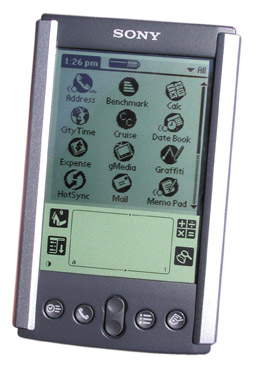
Sony's new Palm has arrived, and the state of Palm OS computing will never be quite the same. Sony's new CLIE (pronounced klee-AY) is a fine work of art, one that really can only be fully appreciated live and in person. Like the Mona Lisa, the Taj Mahal, or the Palm V. Ah yes, that ultimate of benchmarks, the Palm V. While other companies have come out with excellent products in their own right, none has yet sought to rival the jewelry that is the V. Until the Sony CLIE. Note that I say rival, I do not say surpass. In my mind, the Palm V remains the ultimate in design with its sleek metal body and supremely readable screen. But the CLIE also brings some new items to the table that are not a part of the Palm V.
Foremost among these is the Memory Stick slot. Sony's Memory Stick has been integrated into many, if not most, of their recent electronic products, including video cameras, digital cameras, and MP3 players. It is natural, then, that their first Palm OS computer would have one as well. Popping the included 8MB Memory Stick into the slot, we're exposed to examples of two of the three above named applications: video and photographs. Actually, you have to install the gMedia and PG Pocket programs from the supplied CD first. Then you have to go to the program whose name shocked me: MS Gate. It stands for Memory Stick Gateway, not Microsoft Gate. Whew. This is the program you use to copy files to and from the Memory Stick, and it is pretty quick.
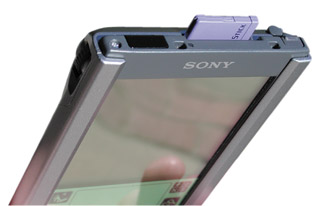
The photographs are crisp as can be expected from a 16 gray scale screen, and the gMedia video is at least 15 frames per second, smooth and fluid. Absolutely amazing. Even ActiveSky cannot yet compare. I tried beaming these two applications to a couple other Palms, and they didn't work, protesting that I needed at least OS 3.5 and either Sony hardware for the video player or VFS Manager for the PG Pocket Viewer. I'm assured, however, by David Yang of Sony Electronics, that these applications are, or will be, available for other Palm users. "That's the beauty of being a part of the Palm community, and why we're so excited about it; users can all have the same applications and communicate between them no matter what hardware they're running," said Yang.
Among the unique things you can do with the CLIE is associate a photograph with an Address Book entry. It's as simple as tapping on the "No Image" that appears in the Edit mode, and you're taken to the PG Pocket Viewer to select your image. From then it's associated with that address and a little camera icon appears next to the name in list view. That's a first, and could be very useful for salespeople.
Fit and form
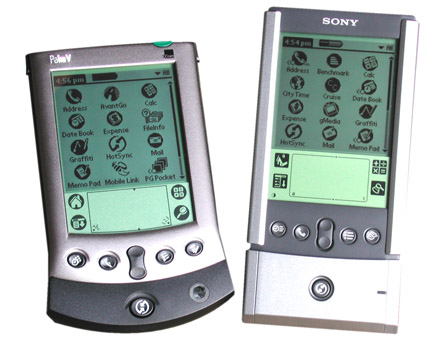
Early photographs of the CLIE, some posted by us on our website, really made it look big. The two silver metallic slab sides give it a monolithic shape, and with no point of reference for relative size, it looked huge. But when you hold one in your hands, you see that it's small, and the slabs serve to give it a classic, strong look that dignifies its small stature. By way of comparison, it's narrower than both the Palm V and the Visor. It is thicker than the V, but its beveled back lets it sit more comfortably and securely in the palm, where the Palm V bites into the hand a bit more and feels like it's going to fall out of my hand. As for weight, the Palm V comes in at 4.5 oz, and the CLIE is 4.4 oz. It's clear that the V was CLIE's target.
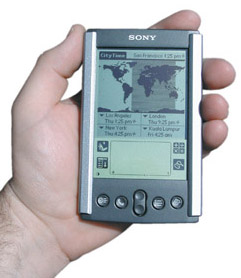
For the right handed person, the CLIE's design is very well thought out. The left index finger rests right where the pen and power button are, on the upper right. It doesn't seem intuitive at first, until you hold it as pictured on page 62. The thumb then rests on another major feature unique to the CLIE: the Jog Dial. This little idea appeared first on Sony's popular cell phone line in the mid-1990s. From the application menu, you can just roll the dial, and out pops a pull-down menu from the left of the screen, filled with all the icons and names of the applications. You can then scroll down to the application you want, and select that application-say, the Address Book-with a simple push on the dial. Then you can scroll through the address listings until you get to the name you want and press the dial again to get your information, all without removing the pen or tapping on the screen. The only drawback is that you can't back out of your selection, as you can with the similar wheel on a RIM 957, which has an escape button. Sony is said to be working on a solution to this problem. Meanwhile, Yang says he changes the Memo Pad button to return you to the Launcher instead.

As I've mentioned, the CLIE is narrower than any other Palm to date, and as such, it has a smaller screen, though thankfully not as small as the Palm m100. It is 1/8 inch smaller than the Palm V. And as the Palm V came up with tighter pixels than the Palm III with a smaller size, so does the CLIE come up with tighter pixels and thus somewhat blacker-looking images. However, the Palm V's background is still that much lighter, so the contrast on the CLIE isn't quite as dramatic as the Palm V. It's still a beautiful screen, and a pleasure to use.
Speaking of pleasure, the CLIE's backlight is like the backlight of the old Palm Pilot, where the background is lit and the pixels remain black. Hallelujah. It is a rich green backlight that is visible even in relatively bright light, yet the pixels are still very readable. It is an excellent implementation that the other manufacturers would do well to return to.
The Memory Stick slot is spring loaded, meaning that you press it down to release it, and a carriage brings it out about an eighth of an inch so you can grab it. If you're not careful, this springloaded carriage can launch the little purple memory stick several feet. It's fun at parties, until you lose it. I have had the same problem with MultiMediaCard slots, so it's a new thing to be careful with on multiple platforms. When you insert or remove the card, you're warned with a standard Palm OS beep so you know that it's been inserted or removed.

Along the bottom runs the HotSync contact strip. Noteable is the increased contact count: going up from the Palm's standard ten contacts, and the Visor's eight USB contacts, to a total of 13 gold contacts, presumably for future peripherals. That's five more than the Visor, though both the CLIE and Visor are USB, so there must be some plans in the works.
Speaking of the Visor, the installation instructions do note that the Visor HotSync will no longer work once you've installed the Sony cradle and software. That's a drawback for someone like me, who of necessity requires multiple devices. I'm not sure why this is, but I aim to find out.
I've noticed a strange thing when beaming between other Palm OS computers. Beam sessions longer than a quick address exchange usually fail unless the units are more than ten inches apart. Even the manual mentions this, though I've never encountered it with other Palm OS computers.
Inside
The Sony uses the same processor as all the current top-of-the-line Palms do: the Dragonball EZ running at 20MHz. It benchmarks at one tick above the Palm Vx, scoring a 122 instead of a 121. There is 8MB of RAM, plus 2MB of Flash RAM where the OS resides, so it is upgradeable. It has a Lithium-Ion rechargeable battery, which charges through the slim, unassuming cradle. A neat feature of the cradle is that the AC power connector disconnects from the back and snaps onto the bottom of the CLIE for charging on the road. The AC block itself is very light, and its power prongs fold down for storage. This is what I mean when I say Sony is about great design. It is in the details where this whole package shines.
The CLIE comes with a carry case that is easily the best that has ever been bundled with a Palm, further enhancing the already fine package. Made from a supple vinyl, it grips the sides of the CLIE with a stiff clamp, and the cover hinges at the bottom and wraps over the top, securing with Velcro. It may not be for everyone, but as I said, it's the best I've seen out of the box.
Getting back to the Memory Stick slot, data is transferred pretty quickly, much faster than the Visor's Flash Module. There is a major difference, however, between the 8MB Memory Stick and Handspring's 8MB Flash Module. The Memory Stick is for data storage and transfer, but programs and live data cannot be accessed from the Memory Stick, whereas with the Visor, plugging in the Flash Module loads the programs located on the module for immediate access. If someone created a Memory Stick reader module for the Visor, it could conceivably be as fast as the MS is in the CLIE. Regardless, the Memory Stick is impressive in its speed and ease of use. I just wanted to make it clear that in order to access the data on a Memory Stick with files from a Sony digital camera, you'd need to go into the MS Gate program and copy the images over to the CLIE's RAM.
The Memory Stick slot will also be useful for peripherals already on the drawing board at Sony. Items include a digital camera module, as well as GPS and Bluetooth modules. Also in development from third parties are a keyboard and a modem; whether that modem is for the Memory Stick slot or the cradle connector is not clear.
Software includes Star-fish Software's TrueSync for compatibilty with Outlook and other PIMs. HotSync seems to take a little longer with this arrangement than I've seen with Chapura's PocketMirror, bundled with the Palm and Visor, but it works well.
The monochrome CLIE was to be launched with the color CLIE, but because of color screen and LCD controller chip shortages, that will likely be delayed until the first half of 2001.
As for the name CLIE, it stands for the four purposes Sony has envisioned for their little handheld: Communication. Link. Information. Entertainment. In Japan it's just called the PEG, for Personal Entertainment Organizer. This particular model is called the PEG-S300.
The Sony CLIE is every bit Palm and every bit Sony, so I don't need to say that it's a beautiful marriage of splendid hardware design and industry-leading interface design. Those considering a Palm V, or any PDA for that matter, should give the Sony CLIE a serious look. It may be the most thoughtfully designed Palm OS computer yet.
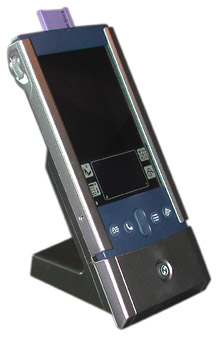
-Shawn Barnett
Back to Palm Section
|



